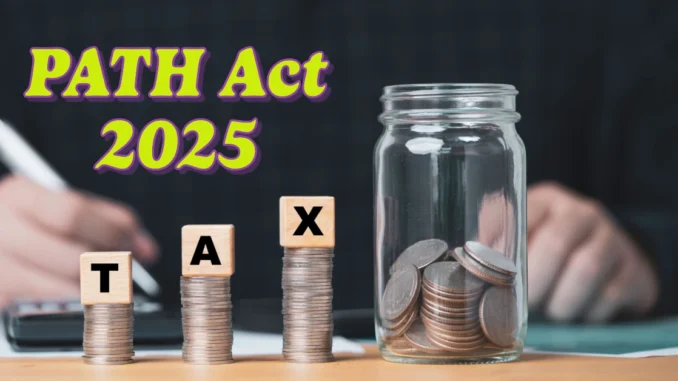
The PATH Act 2025 Refund Dates offer critical insight for taxpayers claiming the Earned Income Tax Credit (EITC) or Additional Child Tax Credit (ACTC). The Protecting Americans from Tax Hikes (PATH) Act helps prevent fraud but can also delay refund processing for eligible taxpayers. This guide outlines the key dates, timelines, and steps to track your refund under the PATH Act for the 2025 tax season.
EITC Direct Deposit Dates 2025: Eligibility, Refunds, and Payment Dates
$500 Family Tax Credit 2025: Eligibility, Income Limits & how to Claim
Table of Contents
What is the PATH Act?
The PATH Act was implemented to combat tax fraud and identity theft, particularly for refundable credits such as the Earned Income Tax Credit (EITC) and the Child Tax Credit (CTC). While this law adds safeguards, it also delays refund processing for taxpayers claiming these credits.
Under the PATH Act, refunds for claims involving the EITC and ACTC cannot be issued before February 15, even if the tax return is submitted early.
IRS Offers Up to $2,000 in Tax Credits for Retirement Contributions 2025: Are You Eligible?
SSA $697 Direct Deposit Rumors: Let’s Clarify the Facts
CalWORKs Check 2025: Eligibility, Benefits, and How to Apply for Monthly Checks
2025 Disability, Retirement, and VA Pay Chart: Payment Dates, Eligibility, and COLA Increase
PATH Act 2025 Refund Dates Overview
| Category | Details |
|---|---|
| Administering Department | Internal Revenue Service (IRS) |
| Program Name | PATH Act Refunds 2025 |
| Eligible Credits | EITC, ACTC |
| Refund Start Date | After February 15, 2025 |
| Refund Timeframe | 3 weeks for e-file; sooner with direct deposit |
| Potential Delays | Paper checks may take longer |
| Official Website | www.irs.gov |
Key Dates for PATH Act Refunds in 2025
- Tax Season Start: January 21, 2025.
- Refund Processing for EITC/ACTC: Begins February 15, 2025.
- Expected Refund Receipt: Most refunds for electronic filings and direct deposit will be processed within three weeks, with many arriving by the last week of February.
IRS Changes in 2025 Could Increase Paychecks and Reduce Taxes
Who’s Exempt? The Complete Guide to FICA Tax and Who Won’t Pay It in 2025
Why Are Refunds Delayed Under the PATH Act?
The PATH Act requires the IRS to delay refunds involving the EITC or ACTC until after February 15. This delay allows the IRS additional time to:
- Verify income and employment information.
- Prevent fraudulent claims.
- Ensure that only eligible taxpayers receive these credits.
Even taxpayers who file early must wait for processing to begin after February 15.
How to Check Your PATH Act Refund Status
You can track the status of your refund by using the IRS’s tools:
Step 1: Use the “Where’s My Refund?” Tool
- Visit the IRS website and access the “Where’s My Refund?” tool.
- Enter your Social Security Number (SSN), filing status, and refund amount to track your claim.
Step 2: Use the IRS2Go Mobile App
- Download the IRS2Go app to track your refund status directly from your smartphone.
Step 3: Monitor Refund Updates
- Stay updated on processing timelines and potential delays by frequently checking the IRS website or app.
What to Do If Your PATH Act Refund Is Delayed
While delays are uncommon for electronically filed refunds, they can occur for various reasons.
Common Causes of Delays
- Errors in Tax Returns
- Incorrect or missing information can delay processing. Double-check your filing before submission.
- Paper Filing or Checks
- Physical tax returns or refunds issued as paper checks may take longer to process.
- Verification Issues
- The IRS may need to verify additional information or documentation.
Steps to Resolve Delays
- Wait 3-4 Weeks: If you haven’t received your refund, give it some time as processing may take up to three weeks.
- Contact the IRS: Call the IRS helpline if your refund status hasn’t changed for over four weeks.
- Visit a Local Office: For persistent issues, visit the nearest IRS office to inquire about your refund status.
Tips to Avoid Refund Delays
- File Electronically: Electronic filings with direct deposit are processed faster than paper returns.
- Ensure Accuracy: Double-check your tax return for errors or missing information.
- Use IRS Tools: Regularly track your refund status using the “Where’s My Refund?” tool or IRS2Go app.
Why the PATH Act Is Important
The PATH Act protects taxpayers and ensures that only eligible individuals receive tax credits like the EITC and ACTC. While the associated delays can be frustrating, these measures reduce fraud and increase the integrity of the tax system.
Stay Updated and Informed
For real-time updates and detailed information about your refund status or delays, visit the IRS’s official website at www.irs.gov. By staying proactive and using the available tools, you can ensure a smoother refund process during the 2025 tax season.
Leave a Reply